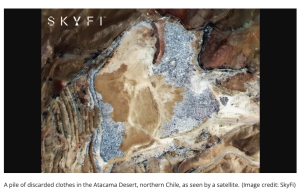I think, not realizing the downside, all of us got caught up in what is known as “fast fashion.” That’s inexpensive clothing produced rapidly by mass market retailers feeding on the latest and rapidly changing trends. This is clothes coming out so quickly and cheaply that we literally have purchasing generations coming up who give no thought to wearing something once or twice (and often not at all) and discarding.
Ever wonder what happens to the tons and tons of clothing discards? Where does it all end up? What’s the environmental impact.” For years I’ve had what I considered three conscientious clothing habits; I am not into fast fashion at all. I have and still wear clothing from graduate school days. When I do toss I always bag up things of good quality and still in good/useable condition and donate to Vietnam Veterans of America. For a long time without questioning, I naively thought these were going to families in need. As I took a closer look I learned of the multibillion used clothing export market.

discarded fashion dumps
seen from space
credit-space.com
In the 2021 global hand-me-down export commodity market the European Union, United States and China sold/exported $2.3 billion worth of clothing discards. That was 44% of the total market. At first glance this seems positive — the buying/importing markets are getting useable clothing cheaper than the cost of new. And, a lot of the discards are reused/repurposed by being converted into yards. Others will be cut up and used as stuffing for cushion. I like the repurpose, reuses aspect and, the job creation in importing countries.
But we can’t look at these without accounting for the other side of the scale.
Global fiber production in 2022, according to a National Geographic Magazine article was 116 million tons of which only 7.9% was recycled. Also, what has to be considered is the energy consumption of all the fiber used in fast fashion. For example, popular polyamide is made from petroleum using an energy intensive process. Even wool has a downside. The CO2 emissions of the wool industry is equivalent to that of aviation. And, it takes 2,000 gallons of water to produce just one pair of jeans.
And there’s a whole other aspect of fast fashion discard that had never occurred to me. What about the tons of purchased/imported discards that are determined as unwanted? In John Bartlett’s article for National Geographic the photos are telling and compelling. These are images of literally tons of clothing and shoes from many of the world’s favorite brands dumped and piling up in landfills in Chile’s Atacama Desert. This is one of the fastest growing dumps for discarded clothing. Critics justly blame this ever expand dump and environmental disaster on the rise of global cheap mass produced fast fashion. According to John Barrett between 2000 and 2014 people began buying 60% more clothing and wearing it for half as long as they used to. Another such landfill near Accra, the capital of Ghana, is said to be 60% clothing and 65 feet high.
According to a Copenhagen Fashion report, of the 100 billion tons of garments produced annually 92 billion tons ends up in landfills. And according to earth.org every second the equivalent of a garbage truck full of discarded clothing is either burned , release toxin into the air, or buried in a landfill. According to stateofmatterapparel.com 11.3 million tons of textile waste ends up in U.S. landfills annually. That is 82 pounds of textile waste per person, per year. According to planetcare.org every year over a million tons of microplastics end up in our oceans. And our washing machines and fast fashion is a big contributor to microplastic pollution. Researchers found that an average 13 pound load of laundry releases roughly 700,000 microscopic fibers make their way to our oceans.
Obviously I could go on and on. And it all sounds scary. What can we each do? Jane Fonda known for her long history of activism and climate advocacy vowed in 2020 to “Never buy another piece of clothing.” We could all do that. What a seismic shift that would be. Or we could avoid fast fashion, focus on buying quality and wearing much longer, prioritize buying items made of sustainable fabrics. You consider avoiding dumping clothing in the trash and repurpose it, give it to a friend or donate. And in traveling what I have discovered is that a lot of cultures make do with much less. Traveling with a friend from France at a stop at a village market I couldn’t decide between two pairs of earrings and bought both. She wasn’t rude but perplexed and asked you’re buying both? I didn’t have a good response. I really didn’t need both… in fact I didn’t NEED either. Do we really need 6 pairs of jeans? 10-20 pairs of shoes? An infinite number of T-shirts?
